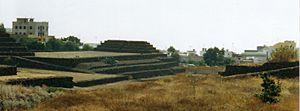Pyramids of Güímar facts for kids
The Pyramids of Güímar are six cool, pyramid-shaped structures found on the island of Tenerife in the Canary Islands, Spain. They are built from lava stone and don't use any mortar (which is like glue for stones). You can find them in a place called Chacona, near the town of Güímar. These pyramids can be as tall as 12 meters (about 39 feet)!
Many people think these pyramids were built in the 1800s. They might have been made when farmers were clearing stones from their fields. There were once nine pyramids in Güímar, but only six are still standing today. You can also find other similar stone structures in different parts of Tenerife.
Contents
Who Studied These Pyramids?
Thor Heyerdahl's Big Idea
In 1990, a famous adventurer named Thor Heyerdahl heard about the "Canarian Pyramids." He was very interested because he had a theory that ancient people might have traveled across the Atlantic Ocean between Egypt and Central America.
Heyerdahl thought the Güímar pyramids could have been a stopping point for these ancient travelers. He wondered if they were like the pyramids in Egypt and the ceremonial areas in Maya lands. This idea caused a lot of discussion among historians, scientists, and people who love history.
Pyramids and the Stars
In 1991, scientists from the Canary Institute of Astrophysics studied the pyramids. They found something amazing: the long sides of some pyramids point towards where the sun sets during the summer solstice (the longest day of the year). Also, the stairs on the western side of the pyramids face where the sun rises during the winter solstice (the shortest day of the year).
If you stand on the biggest pyramid on the summer solstice, you can even see the sun set twice! It sets behind one mountain, then appears again, and then sets behind another mountain. While this is cool, it doesn't tell us exactly why or when the pyramids were built.
In 2005, some researchers wrote a book suggesting that the pyramids' alignment with the sun might have been for Masonic reasons. They noted that the owner of the land where the pyramids stand was a Freemason, and solstices are important in their symbols. This would mean the alignments were for beauty, not for ancient travel or farming.
Digging for Clues: What Archaeologists Found
Between 1991 and 1998, archaeologists from the University of La Laguna dug up the area around the pyramids. They wanted to find out how old they were.
They found three main layers of soil and rocks:
- The top layer (about 20 cm thick) had lots of plant remains and things from the late 1900s.
- The middle layer (about 25 cm thick) had less plant material but many small stones. It contained items from the 1800s and 1900s, including an official seal from 1848.
- The bottom layer (25 to 150 cm thick) was made of small volcanic rocks. It had very few items, mostly small pieces of pottery from the 1800s.
The pyramids sit directly on top of this bottom layer. This means the pyramids could not have been built before the 1800s.
Archaeologists also found a natural lava cave under one of the pyramids. Inside, they found items from the Guanches, who were the native people of the Canary Islands. These items were from between 600 and 1000 AD. However, since the pyramids were built on top of the cave, the Guanche items only tell us when the cave was used, not when the pyramids were built. The studies show the pyramids are from the 1800s.
What We Know About the Pyramids
Most archaeologists believe that the pyramids were built by local farmers in the 1800s. They think the farmers piled up stones in these shapes while clearing their land for farming.
However, Thor Heyerdahl believed that the pyramids were not just random piles of stones. He thought they were connected to the ancient Guanches until he passed away. The "Pyramid Park" and its website still talk about a possible link between the Guanches and the pyramids.
Another idea is that while the pyramids were built in the 1800s, they were still carefully made, not just random piles.
Visiting the Pyramids Today
After the archaeological digs finished in 1998, the area around the pyramids was opened to the public. It's now a 65,000 square meter (about 16-acre) park!
Thor Heyerdahl got help from his friend Fred Olsen, a businessman from the Canary Islands. The park has an information center where visitors can learn about Heyerdahl's amazing trips and his ideas about the pyramids. There are also two buildings with exhibits, including models of his boats, like a full-size replica of his famous boat, the Ra II.
Even though the studies showed the pyramids were built in the 1800s, Heyerdahl continued to believe there might be a link between the pyramids and the ancient Guanche people of Tenerife. In the park's "museum," you can see large photos of the items found in the Guanche cave. The 19th-century pottery found during the digs is only briefly mentioned on an information board, without pictures.
Images for kids
See also
 In Spanish: Pirámides de Güímar para niños
In Spanish: Pirámides de Güímar para niños







